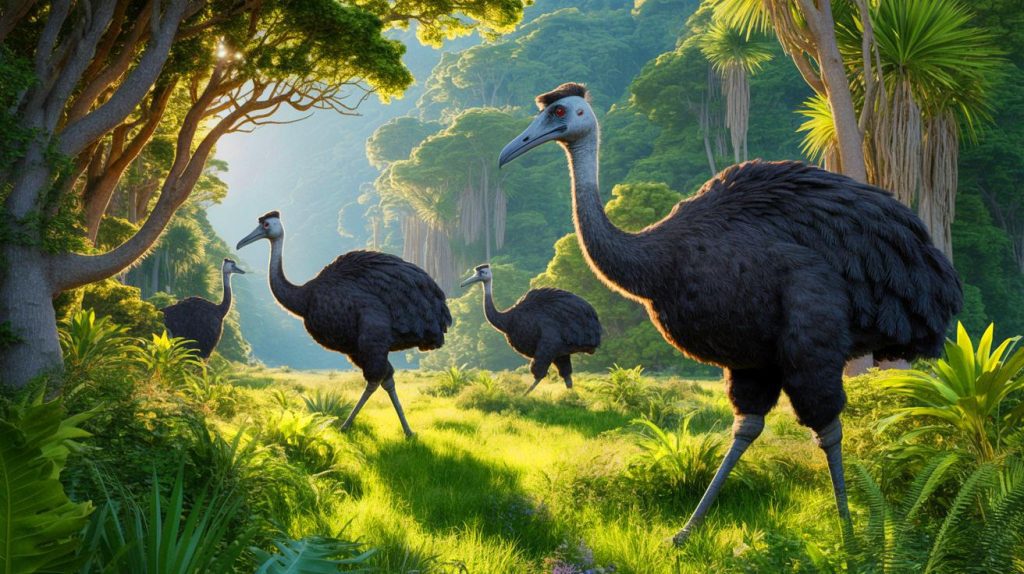| SUMMARY |
|
Colossal Biosciences, recognized for its groundbreaking de-extinction projects, is embarking on an ambitious new endeavor: the potential revival of New Zealand’s giant moa. These flightless birds existed until around 1400 AD, when they were driven to extinction by human activities. Colossal’s goal is to not only resurrect these magnificent creatures but also stimulate ongoing conversations about the ethics and practicality of such scientific undertakings. With advancements in genetics and a commitment to collaboration, this project could transform our approach to biodiversity and conservation.
Colossal Biosciences and Their Ambitious Plans
Colossal Biosciences has already gained attention for its efforts to resurrect the woolly mammoth and the dodo, and now it is focusing on the moa—a majestic bird that once dominated New Zealand’s landscape. The moa serves as both a scientific challenge and a cultural symbol of the nation’s lost natural heritage. These birds could grow over 11 feet tall and weigh as much as 500 pounds, making them significantly larger than modern ostriches.
To realize this vision, Colossal plans to collaborate with indigenous communities, researchers, and experts, partnering with the Ngāi Tahu Research Centre at the University of Canterbury. Their immediate objective is to sequence the genomes of all nine moa species using ancient remains. By harnessing these genetic templates, Colossal hopes to recreate the moa by modifying the DNA of its closest living relatives, like the tinamous and the Australian emu. The project aims to complete these genomic sequences by summer 2026, marking a crucial milestone.
The Science of De-Extinction
De-extinction involves intricate genetic engineering techniques. For the moa, scientists will alter the genomes of closely related species to replicate the extinct bird’s genetic makeup, similar to previous attempts where researchers studied related birds like the Nicobar pigeon for insights into resurrecting the dodo. Beth Shapiro, Colossal’s chief scientist, emphasizes the need to identify the genetic uniqueness of the moa by analyzing its DNA against that of living bird species.
One significant challenge in avian de-extinction is developing bird embryos within eggs, a process that differs markedly from mammalian embryonic development. This necessitates innovative methods for embryo transfer and genetic manipulation. Despite these obstacles, the project has attracted considerable interest and funding, including $15 million from acclaimed filmmaker Peter Jackson and his partner Fran Walsh. Jackson’s personal collection of moa bones highlights the fascination with these ancient creatures.
Ethical Implications and Scientific Debate
While the idea of reviving the moa is exciting, it raises ethical questions in the scientific community. Critics argue that creating an animal that merely resembles an extinct species may not equate to a genuine revival, as original behaviors and ecological roles may not be replicable through genetics alone. Additionally, conservationists are concerned that de-extinction efforts might divert attention and resources from protecting endangered species.
Colossal has faced similar scrutiny with its previous project on dire wolves. Although the company modified gray wolf cells to exhibit traits of dire wolves using CRISPR technology, skepticism lingers regarding the ramifications of such genetic alterations. The ongoing debate questions whether de-extinction is a legitimate conservation strategy or merely a distraction from critical environmental issues. Nonetheless, Colossal’s work showcases the potential of genetic technology to revolutionize biodiversity initiatives.
Looking Ahead
As Colossal Biosciences advances in its moa project, it promises to reshape our understanding of ecology and conservation. Their collaboration with indigenous communities and the scientific field emphasizes a commitment to ethical and sustainable practices. Ultimately, the goal is to reintroduce the moa into the wild, restoring a vital piece of New Zealand’s natural history.
Faced with unprecedented environmental challenges, the possibility of de-extinction presents both promise and controversy. Will these scientific innovations foster a new era of biodiversity restoration, or will they generate more ethical dilemmas than solutions? As we stand on the brink of potentially witnessing the return of the moa, the world watches with eager anticipation. What other species might science resurrect, and how will these initiatives influence the future of conservation?
This article is based on verified sources and supported by editorial technologies.



